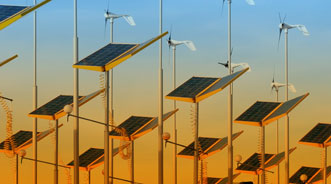Ford, GM Take On Technology & Sustainability with New Projects

By subscribing, you agree to receive communications from Auto Remarketing and our partners in accordance with our Privacy Policy. We may share your information with select partners and sponsors who may contact you about their products and services. You may unsubscribe at any time.
MOUNTAIN VIEW, Calif. and LAKE ORION, Mi –
Technological innovation and a commitment to environmental sustainability are key concepts within today’s auto industry, as evidenced by the announcements of two separate projects within the past week that offer the promise of enhanced personal mobility and the power of harnessed energy.
On Monday, Ford officially opened its Ford Silicon Valley Lab in Palo Alto, Calif., while General Motors has announced a new solar array at its Orion Assembly Plant that will have enough capacity to annually power 45 homes.
So what will comprise each of these projects?
Beginning with Ford’s latest venture, the core mission of the Ford Silicon Valley Lab, or SVL, is to operate as an independent lab focused on the three key areas of big data, open-source innovation and user experience, Ford officials said, all supporting the future of personal mobility.
Executive chairman Bill Ford said, “We have been innovating for more than a century at Ford, but we acknowledge we don’t have a monopoly on creativity. Our new office will complement our existing research efforts by allowing us to tap into the region that has been driving consumer technology forward in recent decades.”
Ford said its fusion of internal and external data sources will help to shape product and marketing offerings and support strategic decision making. Also, vehicle data drawn from sensing technologies built into cars can be used to create a more productive driving experience, then aggregated to help improve efficiency.
Subscribe to Auto Remarketing to stay informed and stay ahead.
By subscribing, you agree to receive communications from Auto Remarketing and our partners in accordance with our Privacy Policy. We may share your information with select partners and sponsors who may contact you about their products and services. You may unsubscribe at any time.
Access to real-time data allows for the rapid development of custom hardware and software applications, Ford said, as the lab looks at open-source development using the research platform OpenXC.
The company is also rethinking the interaction of drivers and passengers with vehicles, and researching innovations in design and new technologies.
“As new ways of processing, curating and filtering information are conceived, the possibilities for enhancing personal mobility are virtually limitless,” said Venkatesh Prasad, general manager of the new lab and senior technical leader of open innovation.
“With many of the finest forward-thinking minds in the world located in the San Francisco Bay region, the Ford Silicon Valley Lab is ideally positioned to interact with and forge connections to local innovators and grow the relationships with our current partners.”
Paul Mascarenas — chief technical officer and vice president of Ford Research and Advanced Engineering — added: “We want Silicon Valley to view Ford as a platform that is open, accessible and ready for their innovative ideas and technologies. We are looking for unexpected solutions for the future, and we believe Silicon Valley is the right place to round out our global research organization.
“We view technology as more than just an impressive list of microprocessors, sensors and software,” he said. “It is the enabler of a safe, intuitive and enjoyable time behind the wheel.”
Ford also has Research and Innovation facilities in Dearborn, Mich.; Aachen, Germany; and Nanjing, China; and technology scouts in Tel Aviv, Israel.
GM’S Solar Array
Meanwhile, at GM, plans call for a field adjacent to the company’s Orion Assembly Plant to soon become home to a solar array with enough capacity to annually power 45 homes in Michigan.
The energy from the 350-kilowatt array, owned by DTE Energy, will be sent back to the grid for use by area homes and businesses, GM reported. In total, the energy saved will be equivalent to avoiding 261 metric tons of carbon-dioxide from entering the atmosphere.
“Last year, we committed to doubling our global solar output at our facilities from 30 megawatts to 60 by 2015,” said Mike Robinson, GM vice president of sustainability and global regulatory affairs. “We believe in harnessing energy from clean, renewable sources because there a solid business case to be made and it’s good for the environment. This array reinforces our progress.”
During the next three years, photovoltaic systems will be installed on customer rooftops or property, as part of DTE Energy’s SolarCurrents pilot program, with the goal of generation 15 megawatts of electricity throughout southeast Michigan.
“SolarCurrents builds on our long partnership with GM to help it become as energy-efficient as possible,” said Trevor Lauer, DTE Energy vice president of marketing & renewables. “Our partnership with GM is another example of how our companies work to build a more energy-efficient and sustainable future.”
The solar array is the latest aspect of Orion’s environmental efforts, which also include lighting upgrades that have save more than a half million dollars while cutting CO2 output by 5,003 metric tons.
Also, the plant is powered by gas from two nearby landfills, saving $1.1 million per year and reducing the amount of sulfur dioxide and nitrogen oxides released into the air, GM officials said. This saves more than 6,300 tons of CO2 from entering the atmosphere, officials noted.
And a new eco paint process that eliminates the need for a primer oven is heated by landfill gas, while using half of the energy per vehicle of the one it replaced. The measure gives the plant the potential to reduce greenhouse gas emissions by about 80,000 metric tons at a full three-shift capacity, which is equivalent to averting the emissions from 14,000 vehicles per year.
In the United States alone, 2.1 percent of GM’s energy consumption comes from renewable resources, the automaker said.


